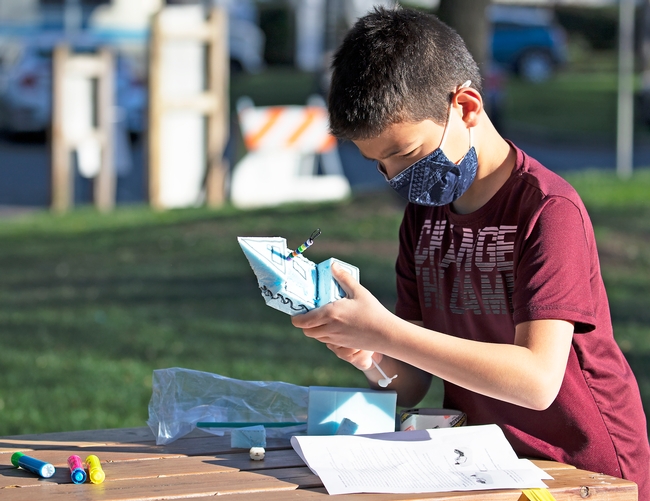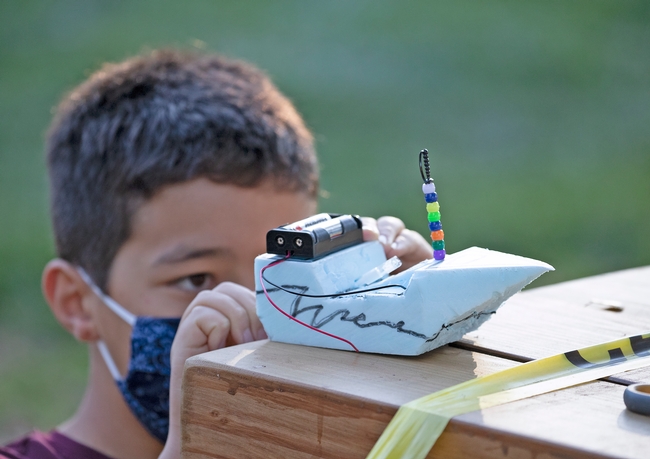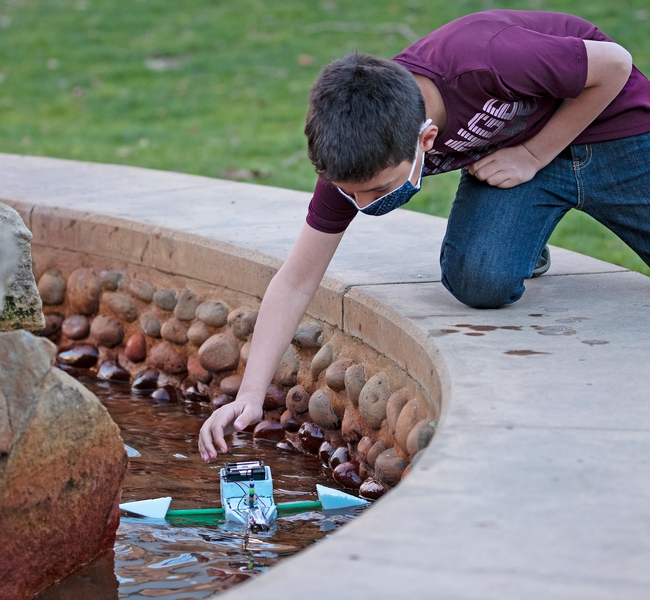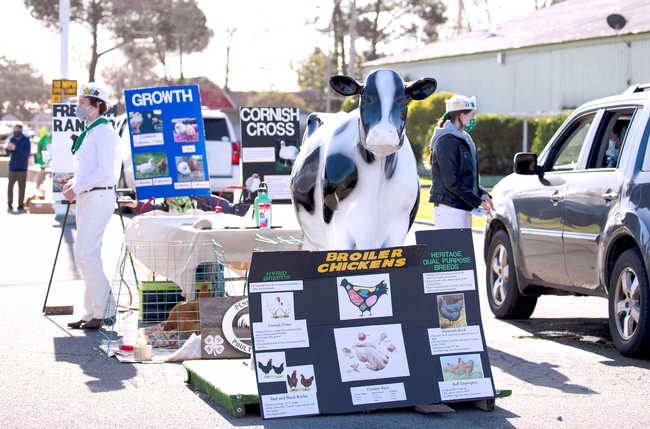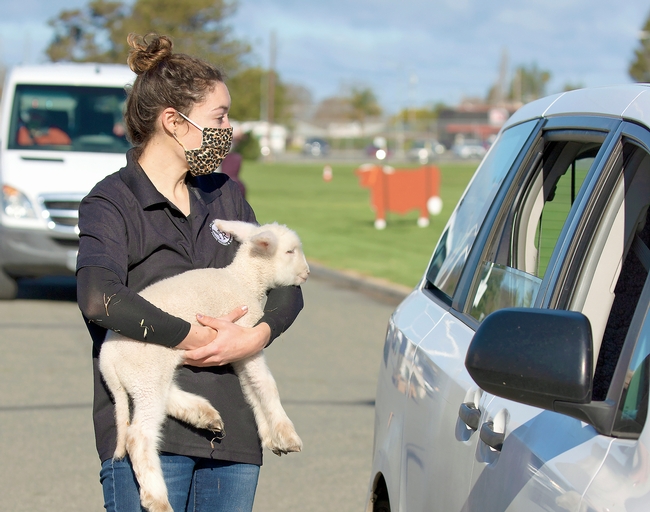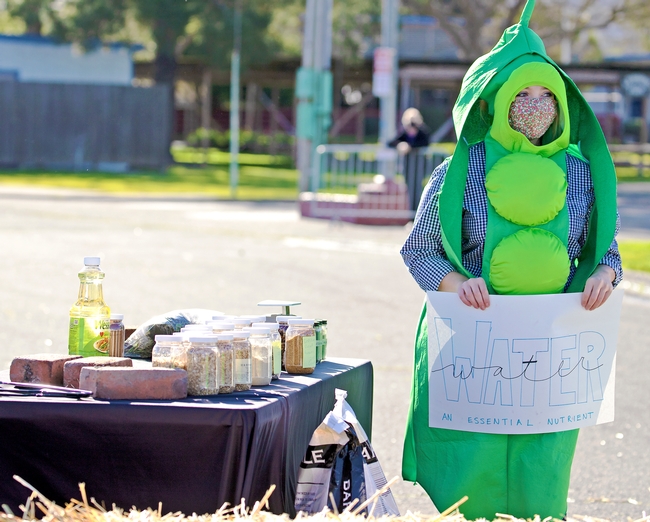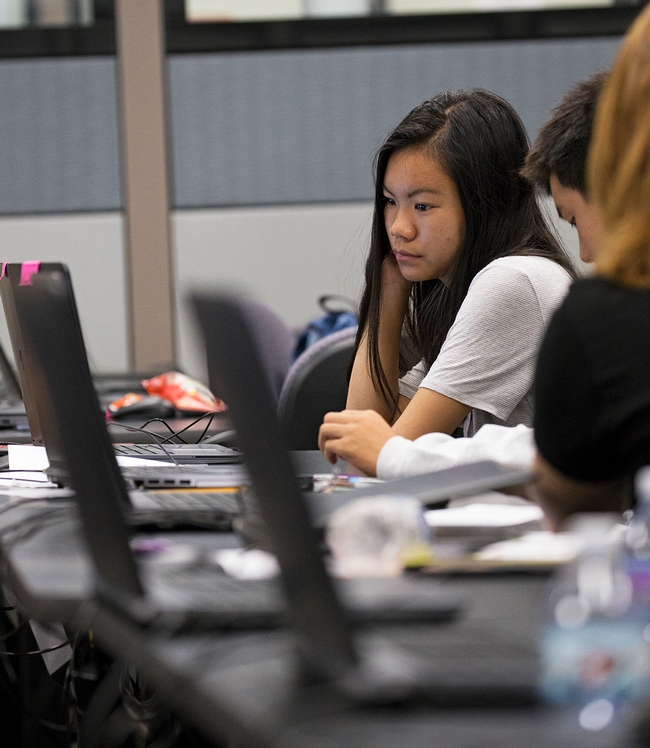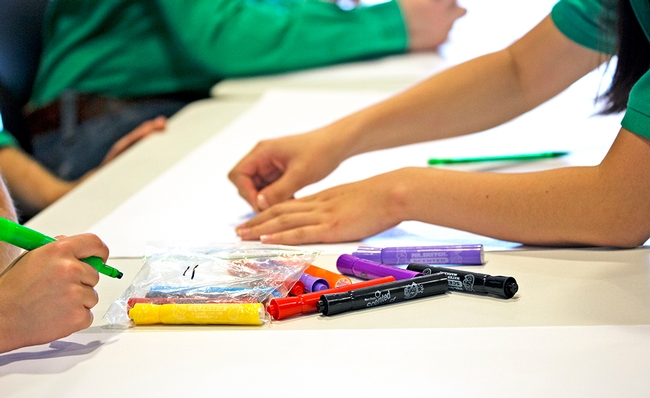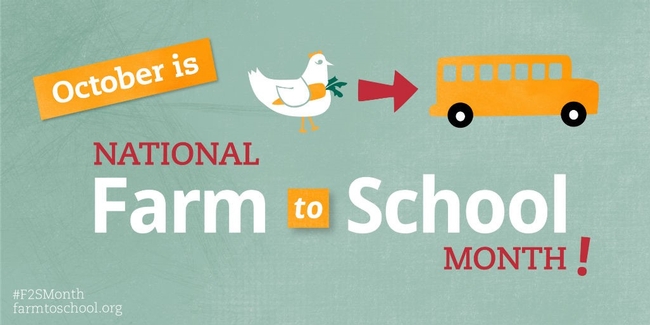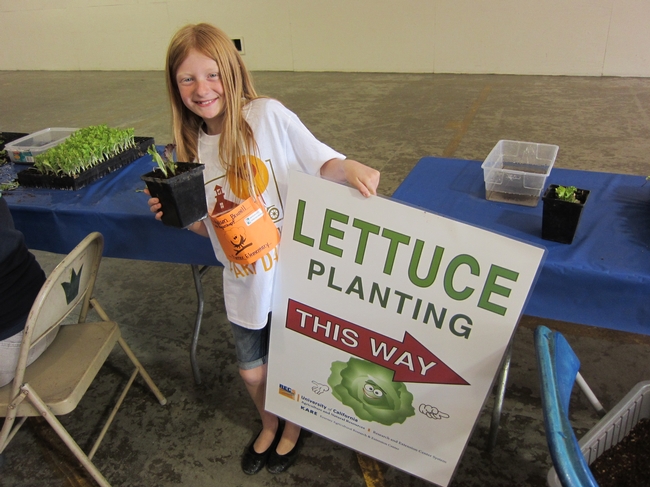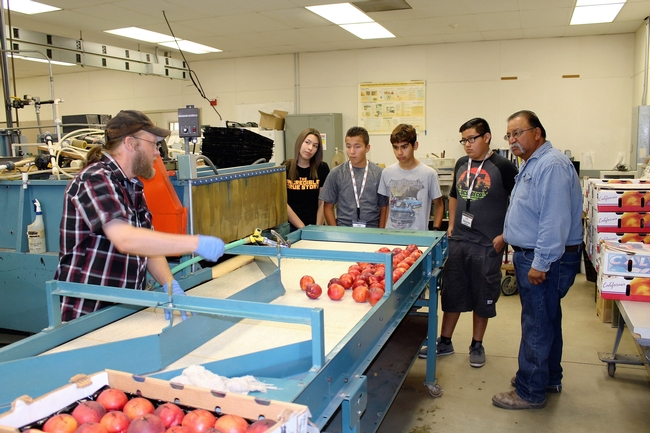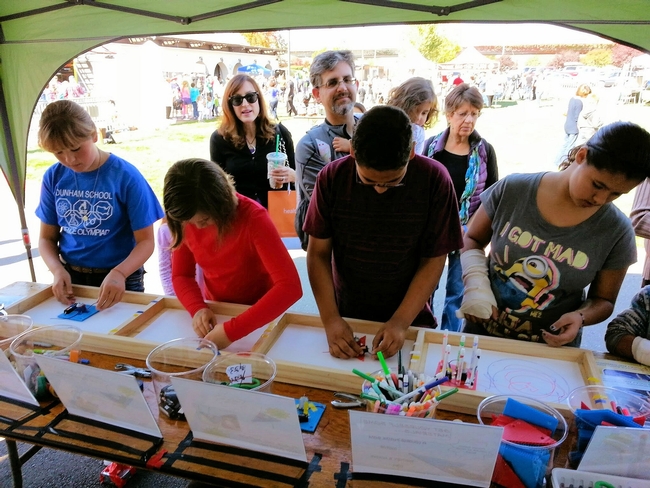Posts Tagged: STEM
4-H’ers 'motor along’ with boat-building and drive-by animal science lessons
As many students continue online learning due to COVID-19, 4-H hands-on learning activities are keeping them excited and engaged in education. The University of California's 4-H Youth Development Program has created several learning activities that allow children to interact within COVID-19 guidelines.
“Despite constraints imposed by the pandemic, 4-H has adapted to continue engaging young people in hands-on STEM learning,” said Steven Worker, Ph.D., UC Cooperative Extension 4-H advisor for Marin, Napa and Sonoma counties.
Students build motorboats for Engineers Week
During Engineers Week, Feb. 21-27, 4-H is challenging kids age 5 to 18 to design, build and test a motorboat.
The activity is intended to spark students' interest in engineering and technology and to exercise their creativity. The boat kit is basic, allowing children to use their imagination, repurposing things around the house to customize their boats.
Starting with a rectangular foam block (2"x2"x8"), youths carve out the body of their toy boats, then install the motor, power switch, propeller and battery holder.
Fifth-grader Sarp Akalin assembled his battery-powered motorboat, which featured a colorful column of white, blue, yellow orange and purple beads, then tested its water worthiness in an outdoor, large stone fountain in Mountain View.
Sarp, who assembled a 4-H Mars rover for a STEM project last year, said the boat was more challenging because the rover kit included all the pieces required to operate the vehicle. To build a functional boat, he had to figure out how to mount the batteries and motor and balance the center of gravity, connect them with electrical wires, then make sure the propeller had the right amount of space spinning freely the right direction to thrust the boat forward.
He learned a few adjustments were needed to float the boat. For example, whenSarp first placed the boat in the water, he let out a yelp as the weight of the battery pack sank the back end. With some guidance from his fatherEmre,Sarp balanced the weight by strapping two batteries to the front end and placed it back in the water. After the boat listed to one side, he converted the boat to a trimaran – a type of sailboat which is mostly used for racing – which stabilized the vessel.
“The best part was seeing it go,” Sarp said of watching his boat propel itself around the large rocks in the turbulent water in the fountain.
On Saturday, Feb. 27, nearly 150 4-H youths from 22 California counties will gather online to show their completed boats, maybe demonstrate them in a bathtub or pool, and describe their design experience.
Participating counties include Alameda, Butte, Contra Costa, Imperial, Kern, Kings, Madera, Monterey, Napa, Riverside, San Diego, San Luis Obispo, San Mateo, Santa Barbara, Santa Clara, Shasta, Solano, Sonoma, Stanislaus, Tulare, Tuolumne, Ventura and Yolo.
“While meeting virtually is not the same as meeting in person, thankfully we have technology to connect us by sight and sound over long distances,” Worker said. “On Saturday, I am eager to see the creativity, ingenuity and persistence young people display in their completed motorboats.”
More information about the boat challenge is at https://ucanr.edu/boat.
Drive-through animal science presentations
In Petaluma, 4-H members learned about animal science at the Sonoma-Marin Fairgrounds on Feb. 20. More than 130 participants drove to presentation stations within the fairgrounds. From the safety of their cars, the youths learned about livestock production. Poultry, beef cattle, dairy cattle, sheep and goat experts from UC Cooperative Extension and local organizations gave presentations.
Randi Black, UCCE dairy advisor, and Amy Housman of Santa Rosa Junior College provided tips for biosecurity to keep animals healthy. Maurice Pitesky, UC Cooperative Extension poultry specialist, and 4-H members Carson Hay, Frances Marshall, Jessica Waterman and Zoey Haines shared information about raising chickens, egg production and broiler production. Sonoma-Marin Cattlewomen and North Bay Dairy Women discussed raising beef and dairy cattle, cattle byproducts, the use of cattle grazing to help reduce wildfire fuel. Sheep and goat production were covered by Erin Monahan of Two Willow Club Lambs, Riggs Lokka and Emily Dulany of Top of the Hill Boer Goats, and Janet and Rebecca Kracker, Sonoma County 4-H leaders.
Members of the Sonoma-Marin Young Farmers and Ranchers and Napa County Young Farmers and Ranchers discussed animals' nutrition needs. “They showed the kids different feedstuffs, broke down the different ingredients that animal feeds contain, and explained what the different feedstuffs do for the animals,” said Suzanne Amaral, UC Cooperative Extension 4-H program coordinator for Napa County.
Julie Atwood of the Halter Project gave suggestions for planning for evacuating livestock in the event of a wildfire.
Join Discovery Day on March 13
Children, teens and families are invited to join 4-H and other Bay Area organizations for North Bay Science Discovery Day on Saturday, March 13. Events are scheduled between 9 a.m. and 6 p.m. Pacific time.
Discovery Day is a designed to spark curiosity and excitement about science, technology, engineering, and mathematics (STEM). A Kaiser Permanente physician will describe how the COVID-19 vaccination works. Kids can learn how rockets launch and make their own at home. They can learn about wildlife conservation from the Petaluma Wildlife Museum. They can design, build and test a 4-H scribbling machine that will make drawings on paper. These and many other activities are planned. For more information and to register, visit https://www.northbayscience.org/2021.
The virtual public science festival is free and open to youth of all ages across California.
Google to support computer science career training for Santa Clara 4-H
4-H members in Santa Clara County will work with Google employees to develop computer science technical skills, digital fluency, creativity and problem solving skills in a new 10-week program made possible with a donation from the Silicon Valley internet search giant.
Youth participants, teen leaders and adult volunteers are now being recruited to take part in the 4-H Computer Science Career Pathway, a weekly series that begins Sept. 27. The pathway will translate abstract concepts into practical experiences the participants can use to explore the field of computer science. Fill out an online interest form to get more information.
“We are thrilled to begin our partnership with Google and prepare our youth for successful careers in any field they choose through this innovative program,” said Fe Moncloa, the UC Cooperative Extension 4-H Youth Development advisor in Santa Clara County.
The outreach will go beyond the 10 weekly sessions. During the first year, an estimated 700 youth in traditional 4-H community clubs, in after-school programs, and in programs offered by partnering community organizations will be touched by 4-H computer science. Booths will be set up at festivals and fairs to reach still more young people.
“There are many different opportunities for our youth to explore computer science,” Moncloa said.
The Santa Clara program is one of dozens funded through the National 4-H Council, which received a $1.5 million grant from Google to build skills youth need for the future. Santa Clara is the only California county involved.
“We don't know what the jobs of tomorrow will look like,” said Charlotte Smith of Google.org when the grant was announced. “Some of them might require computer science skills, but it's much more than that – problem solving, collaboration. We want to give kids as many kinds of tools as we can so they can succeed in any discipline and in any field.”
To reach underserved youth in Santa Clara County, 4-H will partner with two well-established community organizations. Youth Alliance, based in Hollister, provides innovative and culturally relevant services to local youth and families. Youth Alliance offers after-school programs for elementary and junior high school youth to give children a safe place to spend afternoons, get homework help and participate in cultural arts programs.
A second community partner is Sacred Heart Community Service in San Jose, which assists families with a wide variety of needs, including after-school programs, housing, food, nutrition education, citizenship classes and English-as-a-second-language training.
Santa Clara County UC Cooperative Extension 4-H has formed a team to launch the 4-H Computer Science Career Pathway.
UCCE 4-H program representative Claudia Damiani will train college students to offer the computer science curriculum to young people in Youth Alliance and Sacred Heart Community Service programs.
Google employee and 4-H volunteer Curtis Ullerich will teach the computer science curriculum to other volunteers in Santa Clara County.
“Some people think computer science is limited to coding,” Moncloa said. “Curtis, the way he teaches, he presents computer science in a different way. Sure, coding is one element, but there is so much more.”
Fiona Reyes and Santiago Piva are 4-H Teen Leaders in this project. They will teach and mentor youth, and collaborate with Ullerich to extend the curricula to 4-H volunteers.
October is National Farm-to-School Month
Schools across the country are celebrating local connections to local food producers in October during National Farm to School Month. Education and outreach activities such as school gardens, cooking lessons and field trips are teaching students about healthy, local foods and food's journey from the farm to their forks.
There are plenty of opportunities for teachers and schools to celebrate and get involved in National Farm to School Month with the University of California Division of Agriculture and Natural Resources (UC ANR). Here are a few ideas to get you started.
4-H youth development
Launch a 4-H Club at your school. The 4-H Youth Development Program emphasizes enrichment education through inquiry-based learning. Core content areas include Healthy Living as well as Science, Technology, Engineering and Math (STEM). Clubs have access to a wealth of curricula materials exploring food, agriculture and natural resources. 4-H also offers the Ag in the Classroom school enrichment program.
Boots on the ground
Invite UC ANR academics and program staff to your career day or science fair or to make a classroom presentation. Specialists from Master Gardeners, Nutrition Education, Project Learning Tree, California Naturalist and other UC ANR programs know how to engage and inspire your students.
Some programs, including Project Learning Tree, offer "train the trainer" professional development workshops that equip educators with the skills and knowledge to teach concepts in their own classrooms. Project Learning Tree also provides free activity guides to teachers who attend their workshops. The guides highlight differentiated instruction, reading connections, and assessment strategies and offer ideas to integrate technology into classroom instruction,
Research and Extension Centers
Take your students on a field trip to a UC ANR Research and Extension Center (REC). The nine RECs in California are focal points for community participation and for active involvement in current and relevant regional agricultural and natural resource challenges.
Visiting a REC offers students a unique opportunity to learn about food production through the lens of applied science research in plant pathology, integrated pest management, conservation tillage, water conservation, development of new crop varieties, and much more. Some RECs also host extended education programs such as Sustainable You! Summer Camp and FARM SMART.
The 2016 National Farm to School Month theme is One Small Step, which highlights the easy ways anyone can get informed, get involved and take action to advance farm to school in their own communities and across the country.
Each week will have a different focus:
- Education (October 3-7)
- Healthy School Meals (October 10-14)
- Farmers & Producers (October 17-21)
- The Next Generation (October 24-28)
Join the celebrations by signing the One Small Step pledge then take your own small step to support healthy kids, thriving farms and vibrant communities this October by partnering with UC ANR.
This story en español.
Facebook vice president shares his 4-H roots
Andrew Bosworth, vice president of Facebook advertising, was an active 4-H youth in Santa Clara County from age 9 to 19, reported Parija Kavilanz on CNN Money. He said he learned computer programming from a 4-H mentor before eventually attending Harvard, where he met Facebook founder Mark Zuckerberg.
"I was into cooking projects and I raised sheep, pigs, rabbits, guinea pigs," Bosworth told the reporter. "I wore my 4-H uniform and would show my animals at the country fair."
4-H is now focusing on programs in science, technology, engineering and mathematics (STEM) in order to prepare youth for prosperous careers, aiming to reach 10 million youth nationwide by 2025, a 67 percent increase. Much of the growth will be fueled by STEM programming. Bosworth said 4-H's learn-by-doing, hands-on approach is a key to generating interest in STEM.
"If you look back to my experience with 4-H, what was great was that you were doing an activity and building a social skill," said Bosworth. "It was fun. You were doing it with your friends, and you were doing it as part of the community."

